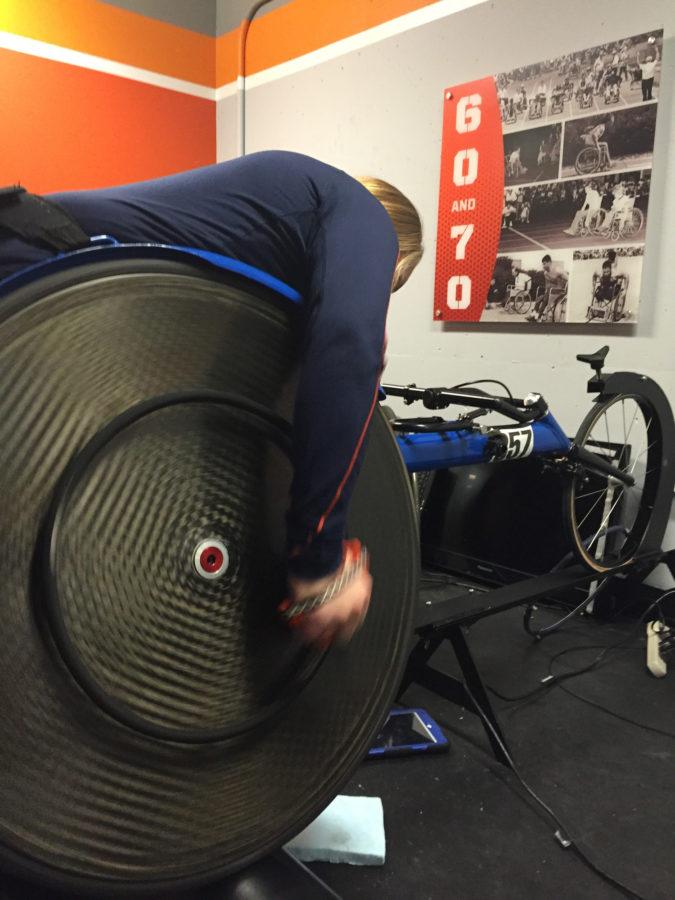New 3-D printer helping Illinois wheelchair racers in marathons
February 29, 2016
TWEET: .@IlliniWCA racers are making gloves with their new 3-D printer #Illini
The U.S.’s only Paralympic training facility on a college campus is in Champaign.CH
The Illinois wheelchair track team’s practice facility in the basement of the Division of Rehabilitation and Educational Support Services building has a collection of dozens of wheelchair racing chairs.
The customized chairs are a rainbow, ranging from purple to green to blue to beyond.
On one wall of the facility’s main room are four collages. Each represents a specific decade in Illinois wheelchair racing history.
Get The Daily Illini in your inbox!
And in each photo, the racers are wearing gloves.
Until the late 1990s, wheelchair racers used leather gloves during
the races, or marathons, in which they stroked their wheels one million
times. The gloves were not thick enough, so they caused blisters and
other soft tissue injuries with the hand.
Athletes started
experimenting with plastic gloves. Those gloves are made by boiling
together a special type of white bead to turn them into a clay-like
material and later mold into a racer’s glove shape that covers their
knuckles. They are then placed into a cold water to harden and
eventually solidify. In 2004, the top athletes started using these
gloves and by 2008, it became the norm.CH
The plastic gloves,
though, have a tendency to crack after millions of
strokes. Ariele Rausin had a solution: buy a 3-D printer to replicate the
plastic gloves.CH
Rausin, a senior in business who has raced in 12
marathons and is pursuing the 2016 Rio Paralympics, got the idea from
one of her class assignments. She needed to scan an object with a 3-D
printer, so she tried a racing glove. It worked perfectly.
Outside of class and racing, Rausin is an Illinois Student Senator,
or ISS. She asked if the group would help buy a $1,200 printer and
three spools of plastic for an additional $96 for the wheelchair track
team. It did, and the printer would be shared by all of the DRES and the
1,750 students it helps.CH
The printer sits in a small square room off of the main training room. It sounds like a regular computer printer, except it doesn’t print paper. It prints gloves.
“On a lot of fronts, it’s really been groundbreaking for the sport, for the team and for us,” head wheelchair track coach Adam Bleakney said.CH
In order to make the gloves, Bleakney gives Rausin worn-out gloves to take to the Beckman Institute or send to a professional company in Michigan to be scanned. There, new gloves are designed in MeshMixer a software that allows a person to customize — change colors, size or add a logo — the gloves.
After they’re finished customizing the glove, it is exported into another software called MarkerBot, which Bleakney compares to a virtual 3-D printer. He then flattens the glove on the virtual printer’s surface and saves it onto an SD card. When the printer finishes producing the gloves, racers sand down and scaffold any parts to smooth the edges.
“I think some of the athletes have … probably gotten six to seven months out of the same gloves, so a pretty solid investment,” Bleakney said.
The wheelchair track team can make new plastic gloves in four to five hours with the new printer, instead of repeating the process with the plastic beads, which takes in upwards of two days. The 3-D-printed gloves are also a third of the weight of the previous plastic glove and are more durable, which allows the racers to push longer without getting as tired and blistered.
Illinois has printed 30 gloves since getting the printer three months ago. Rausin said the team recently got a 3-D scanner to scan gloves quicker than sending them to the Beckman Institute or Michigan. She said it just scratches the surface of the possibilities with 3-D technology.
Rausin plans to print more gloves and wants to try printing wheelchair parts and hand rims.
“(DRES students) can try it if they want to print gloves or whatever, “ Rausin said. “It’s really exciting.”
@32Ryno







